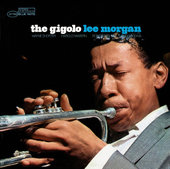Lee Morgan - The Gigolo (1965)
 Nat Hentoff was right on target when he predicted that The Gigolo would come to be regarded in a timeless session. Many Lee Morgan fans have cited the album as one of the trumpeter's best, and it needed features inspired playing on superior program of music. It has also won a special place in listeners' hearts because, as Hentoff could not have known at the time, it represents the final recorded example of one of the greatest trumpet/tenor sax front lines in jazz history.
Nat Hentoff was right on target when he predicted that The Gigolo would come to be regarded in a timeless session. Many Lee Morgan fans have cited the album as one of the trumpeter's best, and it needed features inspired playing on superior program of music. It has also won a special place in listeners' hearts because, as Hentoff could not have known at the time, it represents the final recorded example of one of the greatest trumpet/tenor sax front lines in jazz history.Morgan and Wayne Shorter first joined forces in the summer of 1959 in Art Blakey's Jazz Messengers, where their combination of fire, feeling, wit, and iconoclasm made instant magic. For next two years (until Blakey added trombonist Curtis Fuller to the band shortly before Morgan's departure), their conjoined sound defined one of the greatest periods in Jazz Messenger music on a series of Blue Note albums. As the leading voices in a quintet, they were also featured on albums at the time under the leadership of Wynton Kelly and Shorter on Vee Jay, and on Morgan's own release for Roulette. The Morgan/Shorter partnership on Blue Note, on hiatus for a period while the trumpeter battled personal demons, was reestablished in 1964 and continued intermittenly through 1967. Most of these later encounters involved sextet instrumentations, as on Morgan's Search For the New Land and The Procrastinator, and Blakey's Indestructible; but Night Dreamer (Shorter's first date as a leader), as well as the present sessions, gave us two more quintet gems.
Taken together, Night Dreamer and The Gigolo confirm that Morgan and Shorter remained eminently compatible despite developments in their respective careers that seemed to find them headed in seperate directions. Morgan was enjoying his greatest commercial success with his funky blues hit "The Sidewinder", recorded at the end of 1963, while Shorter was focused on more open and exploratory material as the new member and primary composer in Miles Davis's quintet, which he joined in the summer of 1964. Yet Morgan displays no hesitation in dealing with Shorter's haunting compositions on Night Dreamer, and the music there anticipates ideas Morgan would pursue in his own bands at the end of the decade. Shorter is similarly assured here, in what even at the time were considered the more traditional contours of the present music.
One major change that had taken place since the pair first met was Morgan's growing focus on composition. Unlike his early albums between 1956-1960, in which the vast majority of the writing was left to others, Morgan's Blue Note dates of the 1960s tended to focus heavily and sometimes exclusively on the trumpeter's own creations. His compositions here define a style that, while narrower and more familiar than that of Shorter, encompassed a range of forms and feelings. "Speedball" is the most famous of the originals (it quickly became Morgan's theme in live performances) and the most straighthead, and it includes a 16-bar interlude/coda that is as memorable as the primary 12-bar blues melody. The other two Morgan originals hark back to earlier works by the trumpeter without sounding like mere echoes. "Yes I Can, No You Can't" is clearly fashioned in the mood of "The Sidewinder", but employs a different chorus structure and some of its own harmonic wrinkles. "The Gigolo", heard here in two takes, brings the open 6/8 feel of Morgan's "Search For the New Land" into a structured chorus with a bridge, resulting in a form that recalls a contemporary Freddie Hubbard composition, "Blue Spirits". Each of Morgan's pieces contains a melody that stays in the listener's ear, the true sign of an accomplished writer.
The arrangement of "You Go to My Head" has also become a classic, and remade the standard for many subsequent musicians, in the way that John Coltrane did when he recast "Body and Soul" in 1960. Note also that "Trapped", the only issued performance from the first of the album's two sessions, was listed as Morgan's composition at the time of release but it is actually a Wayne Shorter piece. It might be described as a patterned blues, with ensemble choruses that underscore the rich blends the trumpeter and saxophonist archieved with regularity.
Little need to be added regarding the excellent performances here of the primary horns and the rhythm section. This was a highly compatible group, with each musician at the top of his game and clearly inspired by his partners. Morgan, Mabern, and Higgins had made similar magic earlier in June 1965 on Hank Mobley's Dippin', another title available in a RVG Edition.
No comments:
Post a Comment